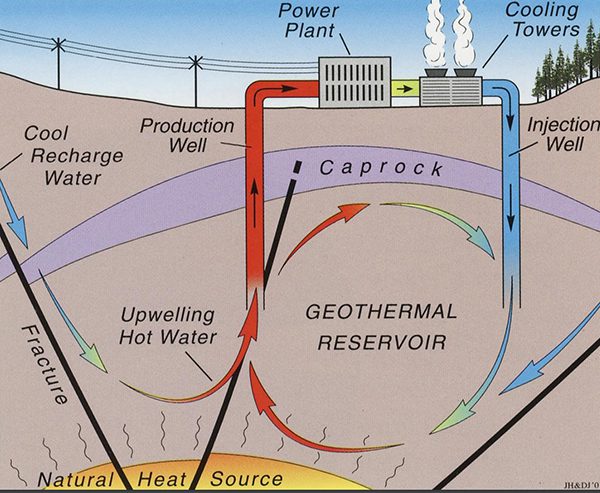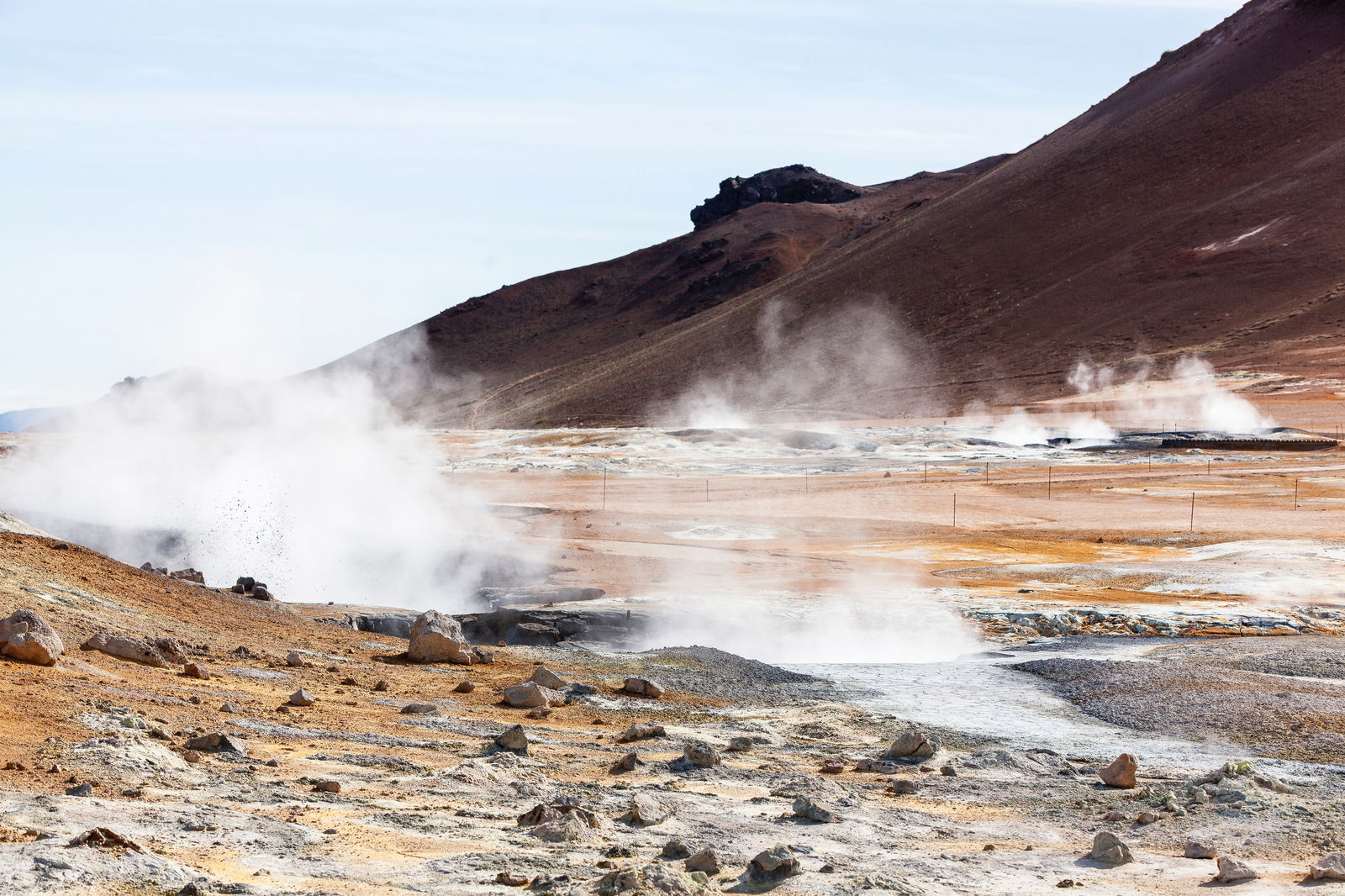Harnessing the earth's energy: Pros and cons of geothermal power plants


· 12 min read
This article is part of our series to spread free & quality sustainability knowledge for all. Compare on Data Hub™ the sustainability performance of geothermal energy leaders: Ormat Technologies, Enel, The AES Corporation and Siemens Energy.
Geothermal power plants have gained significant attention in recent years as an innovative and sustainable way to utilize geothermal energy. These power plants harness the Earth's natural heat to generate geothermal electricity, providing a renewable source of power that offers numerous advantages. By tapping into the Earth's thermal energy, geothermal power plants contribute to a cleaner and greener future.
In this blog, we will explore the advantages and disadvantages of geothermal energy, including the enhanced geothermal system and its potential as a game-changer in the energy sector. Join us as we delve into the depths of geothermal energy and uncover its immense potential for a sustainable future.

The layers beneath the Earth are extremely hot, reaching temperatures of up to 10,800 degrees Fahrenheit (5,980 degrees Celsius), which is as hot as the sun’s surface (Geothermal Explained - U.S. Energy Information Administration (EIA), 2022). Geothermal energy taps into the heat beneath the Earth’s surface and converts it into electricity.

While geothermal energy is a green energy solution with several benefits, it also has drawbacks. Next, we'll delve into its advantages and disadvantages.
Geothermal energy is renewable. Unlike fossil fuels, it isn’t depleted, making it renewable and sustainable. In fact, it’s estimated that geothermal reservoirs could last up to 17 billion years (Allain, 2020).
Geothermal power plants produce minimal greenhouse gas emissions compared to fossil fuel power plants. On average, geothermal power plants produce 99% less carbon dioxide than similarly sized fossil fuel power plants (Geothermal Energy and the Environment - U.S. Energy Information Administration (EIA), 2022).
In fact, one unique type of geothermal plant, known as the binary steam power plant, produces almost zero carbon emissions because it operates in a closed cycle.
Renewables like wind and solar energy are affected by prevailing weather conditions. Geothermal energy isn’t affected by weather conditions, making it a reliable source of baseload energy. This consistent availability makes geothermal energy ideal for meeting constant energy needs.
Solar and wind power stations can't always operate at maximum capacity because their productivity depends on the weather conditions. On the other hand, geothermal power plants can operate at almost maximum capacity almost constantly — typically 90% or higher (U.S. Department of Energy, n.d.).
This quality makes geothermal energy a perfect supplement to intermittent energy sources like solar and wind, making it an essential component of a nation’s renewable energy mix.
While initial installation costs for geothermal energy power plants can be high, the operational costs are significantly lower compared to fossil fuel power plants. Additionally, geothermal power plants can generate electricity at a stable and competitive cost because the cost of geothermal energy isn't affected by volatile energy markets.
As of 2021, capital costs for geothermal power plants in the US ranged between 4,325 and 5,575 USD per kilowatt. In comparison, capital costs for nuclear power plants ranged between 7,800 and 12,800 USD per kilowatt (Statista, 2023).
Beyond electricity generation, geothermal energy has diverse applications. It can be used for heating and cooling in homes, business premises, and industries, reducing reliance on conventional heating and cooling systems and lowering energy bills.
Geothermal power plants require a relatively small piece of land compared to other renewables like solar, wind, and hydropower.
A geothermal energy plant requires roughly 404 square miles of land (1,046 square kilometers), to produce a gigawatt hour (GWh) of electricity. In comparison, a wind power plant requires 1,335 square miles (3,458 square kilometers), while a solar power plant requires about 3,237 square miles (8,384 square kilometers) to produce an equivalent amount of electricity (National Geographic, 2022).
That's about 88% less space for a geothermal power plant than a solar one, producing the same amount of electricity.
There’s a lot of technological innovation happening in the geothermal industry at the moment. For instance, many developments are happening in relation to Enhanced Geothermal Systems (EGS) technology, which can power over 65 million American households (U.S. Department of Energy, n.d.-a). This and other innovations are expected to enhance the feasibility of geothermal energy and mitigate its cons.
Geothermal heat pumps, also known as ground source heat pumps, last longer than conventional heat pumps. On average, they have a lifespan of 24 years, while the underground infrastructure that supports them can last up to 50 years (U.S. Department of Energy, n.d.-c). In comparison, conventional heat pumps last about 15 years.

Geothermal power plants can’t be built anywhere. They can only be built on reservoirs with temperatures of at least 300 degrees Fahrenheit (149 degrees Celsius) (Geothermal Power Plants - U.S. Energy Information Administration (EIA), 2022).
These reservoirs are unevenly distributed across the globe. As a result, areas with limited access to high-temperature geothermal reservoirs can't harness geothermal energy efficiently. For instance, in the U.S., most geothermal plants are in western states, where geothermal energy resources are abundant.
Additionally, seismic activity and geological instability can hinder the construction of geothermal power plants in some areas.
Geothermal power plants require a high initial investment due to expenses such as identifying suitable sites and drilling deep wells. On average, it costs about $2.5 million to build a geothermal power plant with a capacity of 1 megawatt (MW) (U.S. Department of Energy, 2016). In comparison, wind turbines generating the same amount of electricity cost about $1.5 million (U.S. Department of Energy, 2022).
Although geothermal power plants are generally considered environmentally friendly, they still generate small amounts of carbon and sulfur dioxide.
Furthermore, there have been concerns that geothermal power plants can contaminate water because the hot water pumped from underground typically contains traces of heavy metals like mercury, sulfur, and arsenic. However, there have been no reported incidents of water pollution from geothermal plants in the US (Union of Concerned Scientists, 2013).
Geothermal power plants have been linked to increased seismic activity because they alter the Earth’s surface and create new instability along the fault or fracture lines (Scientific American, 2010). For example, in 2017, a geothermal energy project triggered a magnitude 5.5 earthquake in South Korea (Lee et al., 2019).
Although geothermal energy is inexhaustible, geothermal reservoirs can be depleted if the fluid is extracted faster than it can be replaced. For example, the geothermal power plants at the Geysers in the US have experienced decreased output because of overuse (Axelsson & Stefansson, 2002).
Geothermal energy is generally considered a safe energy source. However, as with any energy extraction process, it can cause some risks like surface instability. Therefore, conducting thorough environmental assessments and adhering to regulatory frameworks is essential to ensure geothermal energy is tapped safely and responsibly.
The typical lifespan of a geothermal power plant varies based on factors like the technology it uses and its maintenance and operations practices. However, a well-maintained and properly designed geothermal power plant has a life expectancy of 20 to 50 years.
Yes, geothermal energy is generally considered a good energy source for several reasons. It's environmentally friendly, cost-effective, versatile, and geothermal power plants take up less land than other types of power plants.
illuminem's Data Hub™ tracks companies like Ormat Technologies, Enel, The AES Corporation and Siemens Energy which are leading the way in geothermal energy production and technology. These companies are not only contributing to the global energy mix but are also driving innovation in geothermal power, with a focus on sustainability and clean energy solutions.
The depth at which one must drill for geothermal heating depends on various factors like the geothermal resource and the heating system design. For instance, geothermal heat pumps are typically drilled 10 to 30 feet (3 to 90 meters) deep. On the other hand, enhanced geothermal systems can be drilled as deep as 2.8 miles (4.5 kilometers).
Geothermal power plants offer a sustainable solution for energy generation with minimal environmental impact. They provide large-scale power production while significantly reducing carbon footprint compared to fossil fuel-based plants.
Unlike wind energy or solar installations, geothermal power plants require less surface land, making them suitable for urban areas. Although there are challenges such as potential environmental concerns and high upfront costs, the benefits of geothermal power are undeniable. It is a reliable and renewable energy source that can contribute to reducing our carbon footprint.
Geothermal power plants have the potential to play a significant role in the transition to a sustainable future. By harnessing geothermal energy, we can pave the way for cleaner and greener electricity generation. Let's embrace geothermal power and work towards a more sustainable tomorrow.
illuminem's Data Hub™ tracking sustainability performance data of geothermal energy leaders: Ormat Technologies, Enel, The AES Corporation and Siemens Energy.
Allain, R. (2020, March 10). How Long Could the World Run on Geothermal Power? WIRED. https://www.wired.com/story/how-long-will-earths-geothermal-energy-last/
Axelsson, G., & Stefansson, V. (2002). Sustainable management of geothermal resources. ResearchGate. https://www.researchgate.net/publication/237441900_Sustainable_management_of_geothermal_resources
Geothermal energy and the environment - U.S. Energy Information Administration (EIA). (2022, December 27). https://www.eia.gov/energyexplained/geothermal/geothermal-energy-and-the-environment.php
Geothermal explained - U.S. Energy Information Administration (EIA). (2022, December 27). https://www.eia.gov/energyexplained/geothermal/
Geothermal power plants - U.S. Energy Information Administration (EIA). (2022, December 21). U.S. Energy Information Administration (EIA). https://www.eia.gov/energyexplained/geothermal/geothermal-power-plants.php
Lee, K., Ellsworth, W. L., Giardini, D., Townend, J., Ge, S., Shimamoto, T., Yeo, I. S., Kang, T., Rhie, J., Sheen, D., Chang, C., Woo, J., & Langenbruch, C. (2019). Managing injection-induced seismic risks. Science, 364(6442), 730–732. https://doi.org/10.1126/science.aax1878
National Geographic. (2022, May 20). Geothermal Energy. https://education.nationalgeographic.org/resource/geothermal-energy/
Scientific American. (2010). How does Geothermal Drilling Trigger Earthquakes? Scientific American, 303(3), 100. https://doi.org/10.1038/scientificamerican0910-100
Statista. (2023, January 31). Capital cost of energy production in the U.S. 2021, by technology. https://www.statista.com/statistics/654401/estimated-capital-cost-of-energy-generation-in-the-us-by-technology/
Union of Concerned Scientists. (2013, March 5). Environmental Impacts of Geothermal Energy. https://www.ucsusa.org/resources/environmental-impacts-geothermal-energy
U.S. Department of Energy. (n.d.-a). Enhanced Geothermal Systems. Energy.gov. https://www.energy.gov/eere/geothermal/enhanced-geothermal-systems
U.S. Department of Energy. (n.d.-b). Geothermal FAQs. Energy.gov. https://www.energy.gov/eere/geothermal/geothermal-faqs
U.S. Department of Energy. (n.d.-c). Geothermal Heat Pumps. Energy.gov. https://www.energy.gov/energysaver/geothermal-heat-pumps
U.S. Department of Energy. (2016, November 15). Geothermal Electric Technology | WBDG - Whole Building Design Guide. Whole Building Design Guide. https://www.wbdg.org/resources/geothermal-electric-technology
U.S. Department of Energy. (2022, August 16). Land-Based Wind Market Report: 2022 Edition. Energy.gov. https://www.energy.gov/eere/wind/articles/land-based-wind-market-report-2022-edition
illuminem briefings

Geothermal · AI
illuminem briefings

Geothermal · Energy Transition
illuminem briefings

Geothermal · Renewables
Wired

Green Tech · Geothermal
Atlantic Council

Geothermal · Renewables
Euractiv

Geothermal · Renewables